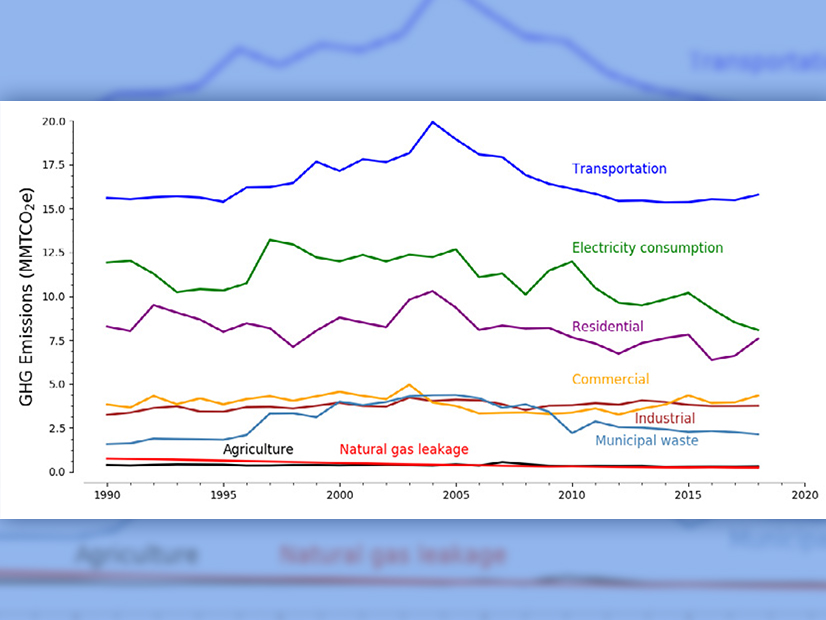
Greenhouse gas emissions in Connecticut are increasing, pushing the state off track from its statutory 2030 and 2050 economy-wide reduction targets, according to a new report from the Department of Energy and Environmental Protection (DEEP).
The Connecticut Greenhouse Gas Emissions Inventory, which tracks the progress on emissions targets, shows that the state emitted 42.2 million metric tons of carbon dioxide equivalent in 2018, the most recent year that data are available. That is 2.9% higher than the state’s 2020 emissions goal and a 2.7% increase from the 2017 inventory.
Transportation emissions, at 15.8 million metric tons, exceeded the combined emissions of the electricity and residential sectors, and have been rising since 1990 despite improvements in fuel economy. In addition, vehicle miles traveled (VMT) have increased faster, further increasing emissions.
“This report demonstrates that there is urgent work to be done for Connecticut to reduce our share of the greenhouse gas emissions that are accelerating climate change,” DEEP Commissioner Katie Dykes said. “Taking action to reduce greenhouse gas emissions will not only help to mitigate the harm and the costs to future generations, but it will also deliver immediate benefits to Connecticut communities today, in terms of cleaner air, better health, more affordable transportation, growing jobs, strengthened infrastructure and better quality of life.”
The inventory makes two recommendations that would require action from the General Assembly.
Significantly reducing transportation emissions will require additional improvements in fuel economy, especially boosting adoption of zero-emission vehicles and reducing VMT. Implementation of the multistate Transportation and Climate Initiative Program (TCI-P) would institute a declining cap on allowable carbon emissions from gasoline and diesel fuel sold and require suppliers to purchase carbon allowances at auction. Auctions allowances would generate revenues up to $89 million in 2023 and as much as $117 million in 2032, which the state would reinvest in programs and infrastructure that reduce transportation emissions. The emissions cap would reduce carbon emissions from on-road transportation by at least 26% between 2022 and 2032.
Buses, light commercial trucks, single unit short haul trucks and similar vehicles produce an increasing share of Connecticut vehicle emissions. Adopting California standards would target zero-emission truck and bus sales for national truck manufacturers and require these companies to sell an increasing number of clean, zero-emission trucks within Connecticut.
There were encouraging results in electricity emissions. The inventory noted a 32% decline in electricity emissions since 1990 and 35% since 2001. The sector’s emissions in 2018 were down 4.7% from 2017, even though warmer weather in 2018 stoked demand. The reduction was ascribed to increased energy efficiency measures in businesses and homes, and increasing use of natural gas and renewables for generation.
Climate Advocates React
A bill to enable TCI-P made it out of the General Assembly’s Environment Committee during the last regular season but not to a full vote. However, TCI-P could be part of the plan for a fall special session. Charles Rothenberger, climate and energy attorney at Save the Sound, said that the inventory “demonstrates that our legislative leaders cannot continue to turn a blind eye to our worsening climate crisis and our state’s failure to meet its own commitments.”
“They must pass the Transportation and Climate Initiative immediately,” Rothenberger said. “This market-based, cap-and-invest program will reduce carbon emissions from the largest source of climate pollution in Connecticut, the transportation sector, while investing in healthy, resilient local communities.”
Lori Brown, executive director of the Connecticut League of Conservation Voters, asked, “What more will it take to convince our state legislators that this is an urgent problem, and that they must act now?
“The same people who deny that climate change is a problem are saying we cannot afford to do anything about it,” Brown said. “They prefer to play politics, dividing us over what should be our common interest of reducing pollution that causes global warming. We expect our elected leaders to step up to the challenge and pass strong climate legislation. Show the public they are not afraid to take action.”
Republican legislators and gasoline trade associations label TCI-P as another gas tax in the form of pass-down costs from fuel suppliers to consumers. Analysis by DEEP shows that Connecticut’s TCI-P participation could boost gas prices by 5 cents/gallon beginning in 2023, assuming fuel suppliers choose to pass down 100% of allowance costs to consumers. Multiple consumer protection safeguards, including a cost-containment reserve, would kick in at 9 cents/gallon. Opponents counter that the 5- to 9-cent increase applies only to the first year of TCI-P, with prices potentially rising by as much as 26 cents. (See Conn. DEEP Commissioner Still Stumping for TCI-P Passage.)

